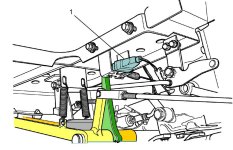Don, when you look under the left operator's platform, you should see something like the picture below. I've tinted the illustration for ease of description. Most of the parts you'll see will be black. The pedals are the two items shown here as yellow and gold. Between the pedals is a wedged shaped bracket (green) that extends upward to the cruise control brake release switch (light blue). With both pedals released (normal postion without brakes applied) the bracket should be pressing against the switch, holding it depressed. You can loosen the screws holding the switch and adjust it until the switch button is depressed. That's the correct position.
When you depress both brake pedals at once, the triangular bracket will move forward, away from the switch and releases the button. This is what sends a signal to the cruise circuit telling it that the brakes are applied and cruise should be turned OFF.
To review: 1. With the brakes released, the switch button should be depressed. 2. With the brakes applied, the switch button should be released.
Now, here is the fun part. If you release the lever that ties the pedals together and press only one brake pedal at a time, the triangular bracket does not move. Therefore, if you split your brakes, you can use the left or right brake to help you turn without disengaging cruise. Only when you step on both pedals at the same time is cruise disabled.
Additionally, there is NO brake light on your tractor. You have only directional turn signals and emergency flashers. The brake pedal switch only functions to enable or disable cruise control.
Finally, don't get the cruise brake release switch mixed up with the parking brake switch. The parking brake switch is in front of the cruise switch and is operated by the toothed lever that holds the brake pedal(s) depressed when you set the brake by pulling up on the PB handle.
